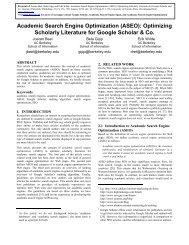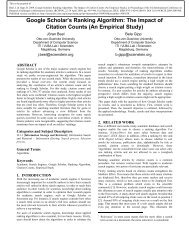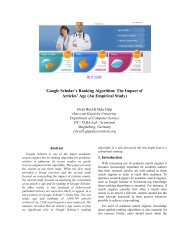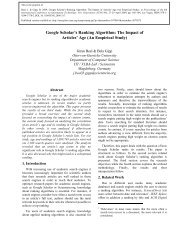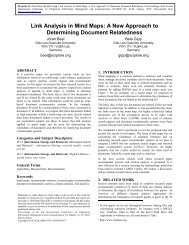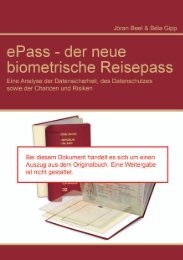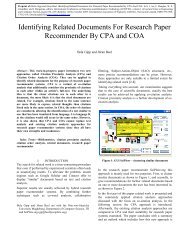Information retrieval on mind maps â what could it be ... - Jöran Beel
Information retrieval on mind maps â what could it be ... - Jöran Beel
Information retrieval on mind maps â what could it be ... - Jöran Beel
Create successful ePaper yourself
Turn your PDF publications into a flip-book with our unique Google optimized e-Paper software.
VI.DETERMINING WORD RELATEDNESSKnowing how words are related is important for manyapplicati<strong>on</strong>s. For instance, search engines want to determinesyn<strong>on</strong>yms [27-29] and offer search query recommendati<strong>on</strong>s[30-32]; social tagging systems often recommend related tagsto their users [33-35]; and, am<strong>on</strong>g others, for web 2.0applicati<strong>on</strong>s, (semi) automatic generati<strong>on</strong> of <strong>on</strong>tologies isdesirable [36-38]. Again, <strong>it</strong> seems likely that informati<strong>on</strong><str<strong>on</strong>g>retrieval</str<strong>on</strong>g> <strong>on</strong> <strong>mind</strong> <strong>maps</strong> <strong>could</strong> help enhancing theseapplicati<strong>on</strong>s.A <strong>mind</strong> map is a graph and nodes are in hierarchical order.As such the nodes’ terms are in direct relati<strong>on</strong> to each other.For instance, in Figure 3: Based <strong>on</strong> the <strong>mind</strong> map a searchquery recommender <strong>could</strong> recommend the terms ‘problems’ or‘defin<strong>it</strong>i<strong>on</strong>’ to some<strong>on</strong>e searching for ‘c<strong>it</strong>ati<strong>on</strong> analysis’ inorder to specify his search. Or, if a pers<strong>on</strong> is searching for‘c<strong>it</strong>ati<strong>on</strong> analysis’, then ‘peer review’ might <strong>be</strong> an interestingsearch term to broaden the search.VII. DISCUSSION AND FURTHER RESEARCHIn this paper we presented how data of <strong>mind</strong> <strong>maps</strong> <strong>could</strong> <strong>be</strong>used to enhance expert search, document summarizati<strong>on</strong>,keyword based search engines, document recommendersystems and determining word relatedness. The presented ideasare not yet supported by research and <strong>it</strong> <strong>could</strong> turn out that dataof <strong>mind</strong> <strong>maps</strong> is not able to enhance the menti<strong>on</strong>edapplicati<strong>on</strong>s. In add<strong>it</strong>i<strong>on</strong>, two more challenges exist. First, <strong>it</strong> isunknown if a sufficient num<strong>be</strong>r of people create <strong>mind</strong> <strong>maps</strong>and if they are willing to share their data. Sec<strong>on</strong>d, therobustness of data seems cr<strong>it</strong>ical. All platforms analyzing dataof users do have to cope w<strong>it</strong>h spam and fraud as so<strong>on</strong> as they<strong>be</strong>come successful. There is no reas<strong>on</strong> to assume that thiswould <strong>be</strong> different if informati<strong>on</strong> <str<strong>on</strong>g>retrieval</str<strong>on</strong>g> <strong>on</strong> <strong>mind</strong> <strong>maps</strong><strong>be</strong>came successful.As part of the SciPlore.org project we will further researchinformati<strong>on</strong> <str<strong>on</strong>g>retrieval</str<strong>on</strong>g> <strong>on</strong> <strong>mind</strong> <strong>maps</strong>. Recently we developed aspecial <strong>mind</strong> mapping software focusing <strong>on</strong> researchers needs[39]. This software will help to gather and analyze <strong>mind</strong> <strong>maps</strong>in order to see if the here presented ideas may <strong>be</strong> realized.REFERENCES[1] T<strong>on</strong>i Buzan. Making the Most of your Mind. Pan Books, 1977.[2] Open Directory Project DMOZ. Open Directory - Reference: KnowledgeManagement: Knowledge Creati<strong>on</strong>: Mind Mapping: Software. Webs<strong>it</strong>e, Juli2009. URLhttp://www.dmoz.org/Reference/Knowledge_Management/Knowledge_Creati<strong>on</strong>/Mind_Mapping/Software//.[3] Mind-Mapping.org. Software for <strong>mind</strong>mapping and informati<strong>on</strong>organisati<strong>on</strong>. Webs<strong>it</strong>e, Juli 2009. URL http://www.<strong>mind</strong>-mapping.org/<strong>mind</strong>mappingsoftware/35?selectedCategories[]=<strong>mind</strong>%20<strong>maps</strong>&selectedOSes[]=all%20operating%20systems&pastOrPresent[]=current&datePicker2=&filterData=Show+selected+<strong>it</strong>ems.[4] MindJet. MindJet: About MindJet. Webs<strong>it</strong>e, Juli 2009. URLhttp://www.<strong>mind</strong>jet.com/about/.[5] SourceForge. SourceForge.net: Project Statistics for FreeMind. Webs<strong>it</strong>e,2008. URLhttp://sourceforge.net/project/stats/detail.php?group_id=7118&ugn=free<strong>mind</strong>&type=prdownload&mode=year&year=2008&package_ihttp://sourceforge.net/project/stats/detail.php?group_id=7118&ugn=free<strong>mind</strong>&type=prdownload&mode=year&year=2008&package_id=0.[6] Sanford B. Frumker. Mind Map: Your Guide to Prosper<strong>it</strong>y andFulfillment. Health Associates, 1993.[7] Anth<strong>on</strong>y J. Mento, Patrick Martinelli, and Raym<strong>on</strong>d M. J<strong>on</strong>es. MindMapping in Executive Educati<strong>on</strong>: Applicati<strong>on</strong>s and Outcomes. The Journal ofManagement Development, 4(4), 1999.[8] Claire A. Michelini. Mind Map: A New Way to Teach Patients and Staff.Home Healthcare Nurse, 18(5):318–322, 2000.[9] Steve Morris and Jane Sm<strong>it</strong>h. Understanding <strong>mind</strong> <strong>maps</strong> in a week.Hodder & Stought<strong>on</strong>, 1998.[10] T.H. Davenport and L. Prusak. Working knowledge: How organizati<strong>on</strong>smanage <strong>what</strong> they know. Ubiqu<strong>it</strong>y, 1(24), 2000.[11] ME Mar<strong>on</strong>, S. Curry, and P. Thomps<strong>on</strong>. An inductive search system:Theory, design, and implementati<strong>on</strong>. IEEE Transacti<strong>on</strong>s <strong>on</strong> Systems, Man andCy<strong>be</strong>rnetics, 16(1):21–28, 1986.[12] C.S. Camp<strong>be</strong>ll, P.P. Maglio, A. Cozzi, and B. Dom. Expertiseidentificati<strong>on</strong> using email communicati<strong>on</strong>s. In Proceedings of the twelfthinternati<strong>on</strong>al c<strong>on</strong>ference <strong>on</strong> <str<strong>on</strong>g>Informati<strong>on</strong></str<strong>on</strong>g> and knowledge management, pages528–531. ACM New York, NY, USA, 2003.[13] N. Craswell, D. Hawking, A.M. Vercoustre, and P. Wilkins. P@nopticexpert: Searching for experts not just for documents. In Ausweb PosterProceedings, Queensland, Australia, 2001.[14] B. Dom, I. Eir<strong>on</strong>, A. Cozzi, and Y. Zhang. Graph-based rankingalgor<strong>it</strong>hms for e-mail expertise analysis. In Proceedings of the 8th ACMSIGMOD workshop <strong>on</strong> Research issues in data mining and knowledgediscovery, pages 42–48. ACM New York, NY, USA, 2003.[15] M. Maybury, R. D'Amore, and D. House. Expert finding for collaborativevirtual envir<strong>on</strong>ments. 2001.[16] J. Wang, Z. Chen, L. Tao, W.Y. Ma, and L. Wenyin. Ranking user'srelevance to a topic through link analysis <strong>on</strong> web logs. In Proceedings of the4th internati<strong>on</strong>al workshop <strong>on</strong> Web informati<strong>on</strong> and data management, pages49–54. ACM New York, NY, USA, 2002.[17] HP Luhn. The automatic creati<strong>on</strong> of l<strong>it</strong>erature abstracts. Advances inAutomatic Text Summarizati<strong>on</strong>. MIT Press, Cambridge, MA, pages 58–63,1956.[18] CD Paice. The automatic generati<strong>on</strong> of l<strong>it</strong>erature abstracts: an approachbased <strong>on</strong> the identificati<strong>on</strong> of self-indicating phrases. In Proceedings of the3rd annual ACM c<strong>on</strong>ference <strong>on</strong> Research and development in informati<strong>on</strong><str<strong>on</strong>g>retrieval</str<strong>on</strong>g>, pages 172–191. Butterworth & Co. Kent, UK, UK, 1980.[19] CD Paice. C<strong>on</strong>structing l<strong>it</strong>erature abstracts by computer: techniques andprospects. <str<strong>on</strong>g>Informati<strong>on</strong></str<strong>on</strong>g> Processing and Management: an Internati<strong>on</strong>alJournal, 26(1):171–186, 1990.[20] J.Y. Delort, B. Bouch<strong>on</strong>-Meunier, and M. Rifqi. Enhanced web documentsummarizati<strong>on</strong> using hyperlinks. In Proceedings of the fourteenth ACMc<strong>on</strong>ference <strong>on</strong> Hypertext and hypermedia, pages 208–215. ACM New York,NY, USA, 2003.[21] H. Zhang, Z.C.W. Ma, and Q. Cai. A study for documents summarizati<strong>on</strong>based <strong>on</strong> pers<strong>on</strong>al annotati<strong>on</strong>. In Proceedings of the HLT-NAACL 03 <strong>on</strong> Textsummarizati<strong>on</strong> workshop-Volume 5, pages 41–48. Associati<strong>on</strong> forComputati<strong>on</strong>al Linguistics Morristown, NJ, USA, 2003.[22] M.Y. Kan, J.L. Klavans, and K.R. McKeown. Using the annotatedbibliography as a resource for indicative summarizati<strong>on</strong>. Arxiv preprintcs/0206007, 2002.[23] D. Lee, K. Jaewoo, M. Prasenj<strong>it</strong>, L. Giles, and O. Byung-W<strong>on</strong>. Are yourc<strong>it</strong>ati<strong>on</strong>s clean? Communicati<strong>on</strong>s of the ACM, 50:33–38, 2007.[24] X. Qi and B.D. Davis<strong>on</strong>. Classifiers w<strong>it</strong>hout borders: incorporatingfielded text from neighboring web pages. In Proceedings of the 31st annualinternati<strong>on</strong>al ACM SIGIR c<strong>on</strong>ference <strong>on</strong> Research and development ininformati<strong>on</strong> <str<strong>on</strong>g>retrieval</str<strong>on</strong>g>, pages 643–650. ACM New York, NY, USA, 2008.[25] Bela Gipp, Jöran <strong>Beel</strong>, and Christian Hentschel. Scienstein: A ResearchPaper Recommender System. In Internati<strong>on</strong>al C<strong>on</strong>ference <strong>on</strong> EmergingTrends in Computing (ICETiC'09), pages 309–315. IEEE, January 2009.Available <strong>on</strong> http://www.sciplore.org.[26] Bela Gipp and Jöran <strong>Beel</strong>. C<strong>it</strong>ati<strong>on</strong> Proxim<strong>it</strong>y Analysis (CPA) - A newapproach for identifying related work based <strong>on</strong> Co-C<strong>it</strong>ati<strong>on</strong> Analysis. InProceedings of the 12th Internati<strong>on</strong>al C<strong>on</strong>ference <strong>on</strong> Scientometrics andInformetrics (ISSI'09), pages 571–575. Internati<strong>on</strong>al Society forScientometrics and Informetrics, July 2009. Available <strong>on</strong>http://www.sciplore.org.[27] V.D. Bl<strong>on</strong>del, A. Gajardo, M. Heymans, P. Senellart, and P. Van Dooren.A measure of similar<strong>it</strong>y <strong>be</strong>tween graph vertices: Applicati<strong>on</strong>s to syn<strong>on</strong>ymextracti<strong>on</strong> and web searching. Siam Review, 46(4):647–666, 2004.



